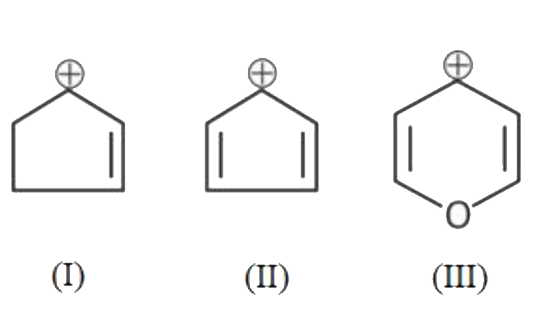What is the effect of introducing an alkyl group on the stability of carbocation?
To answer the question regarding the effect of introducing an alkyl group on the stability of a carbocation, we can break down the explanation into clear steps:
1. Understanding Carbocations:
- A carbocation is a positively charged carbon atom that has only six electrons in its valence shell, making it electron-deficient and unstable.
2. Factors Affecting Carbocation Stability:
- The stability of carbocations is influenced by the presence of electron-donating or electron-withdrawing groups.
- Electron-donating groups stabilize carbocations by providing additional electron density.
3. Role of Alkyl Groups:
- Alkyl groups (such as methyl, ethyl, propyl, etc.) are considered electron-donating groups due to their ability to release electron density through hyperconjugation and inductive effects.
- When an alkyl group is introduced to a carbocation, it donates electron density to the positively charged carbon atom.
4. Stability Increase:
- The introduction of alkyl groups increases the stability of the carbocation. This is because the electron-donating effect of the alkyl group helps to alleviate the positive charge on the carbon atom.
- The more alkyl groups attached to the carbocation, the greater the stability. For example, tertiary carbocations (with three alkyl groups) are more stable than secondary (with two) or primary (with one) carbocations.
5. Conclusion:
- Therefore, introducing an alkyl group to a carbocation increases its stability due to the electron-releasing nature of the alkyl group.
Final Answer:
The introduction of an alkyl group increases the stability of a carbocation because alkyl groups are electron-donating, which helps to stabilize the positive charge on the carbocation.
---
- A carbocation is a positively charged carbon atom that has only six electrons in its valence shell, making it electron-deficient and unstable.
- The stability of carbocations is influenced by the presence of electron-donating or electron-withdrawing groups.
- Electron-donating groups stabilize carbocations by providing additional electron density.
- Alkyl groups (such as methyl, ethyl, propyl, etc.) are considered electron-donating groups due to their ability to release electron density through hyperconjugation and inductive effects.
- When an alkyl group is introduced to a carbocation, it donates electron density to the positively charged carbon atom.
- The introduction of alkyl groups increases the stability of the carbocation. This is because the electron-donating effect of the alkyl group helps to alleviate the positive charge on the carbon atom.
- The more alkyl groups attached to the carbocation, the greater the stability. For example, tertiary carbocations (with three alkyl groups) are more stable than secondary (with two) or primary (with one) carbocations.
- Therefore, introducing an alkyl group to a carbocation increases its stability due to the electron-releasing nature of the alkyl group.
The introduction of an alkyl group increases the stability of a carbocation because alkyl groups are electron-donating, which helps to stabilize the positive charge on the carbocation.
Similar Questions
Knowledge Check
Which of the following orders is correct for the stability of these carbocations?
 AQ>R>PBP>Q>RCQ>P>RDR>P>Q
AQ>R>PBP>Q>RCQ>P>RDR>P>QAlkyl halides are formed when thionyl chloride and _____ are refluxed in presence of pyridine. The order of reactivity (3∘>2∘>1∘) is due to +1 effect of the alkyl group which____ the polarity of C-X bond.
Aacids, decreasesBalcohols, increasesCaldehydes, changesDketones, decreases
what is 3° carbocation ?
View SolutionCompare the stability of following carbocations .

View Solution(A) Tertiary carbocations are generally formed more easily than primary carbocations.
(R) Hyperconjugation as well as inductive effect due to additional alkyl groups stabilize tertiary cabocations.
View SolutionWhat is the state of hybridisation of carbocation?
View SolutionReaction intermdiates are short lived species and are highly reactive. They are formed by heterolytic and homolytic bond fission. There are various types of reaction intermediates in which the most important are carbocation , carbanion and free radical.
Carbocation is an organic species in which carbon have positive charge and six electrons in its outermost shell. The stability of carbocation can be increased by positive inductive effect, hyperconjugation and delocalisation. If α-atom with respect to carbocation has one or more lone pair of electron then lone pair of electron strongly stabilises the carbocation due to octet completion.
Species in which carbon have negative charge is called carbanion. Carbanion carries three bond pairs and one lone pair. The stability of carbanion can be increased by negative inductive effect, negative mesomeric effect and delocalisation.
Free radical is a species which have seven electrons in its outermost shell. The stability of free radical can be increased by hyperconjugation and delocalisation.
The stability order of following carbocations is

View SolutionReaction intermdiates are short lived species and are highly reactive. They are formed by heterolytic and homolytic bond fission. There are various types of reaction intermediates in which the most important are carbocation , carbanion and free radical.
Carbocation is an organic species in which carbon have positive charge and six electrons in its outermost shell. The stability of carbocation can be increased by positive inductive effect, hyperconjugation and delocalisation. If α-atom with respect to carbocation has one or more lone pair of electron then lone pair of electron strongly stabilises the carbocation due to octet completion.
Species in which carbon have negative charge is called carbanion. Carbanion carries three bond pairs and one lone pair. The stability of carbanion can be increased by negative inductive effect, negative mesomeric effect and delocalisation.
Free radical is a species which have seven electrons in its outermost shell. The stability of free radical can be increased by hyperconjugation and delocalisation.
The stability order of following free radicals is:
C6H5CIH2⋅CH2 CH3CIIH2⋅CH2 C6H5 III⋅CH2 CH⋅3IV
View Solution
